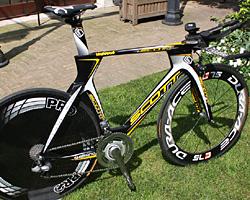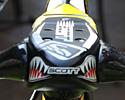
Recently on Cyclingnews.com |
Race tech: Giro d'Italia, May 10, 2009
Scott introduces new Plasma 3 time trial machine at Giro d'Italia
By James Huang in Venice, Italy

|
Scott Bicycles today [*Friday] officially unveiled their new Plasma 3 time trial bike to be used by the Columbia-High Road team in this year's Giro d'Italia. The most fundamental change relative to the extent multisport-oriented Plasma 2 is the revised geometry which is now better suited for time trials with a significantly lower front end though aerodynamics have also supposedly been improved as well with the help of former Formula 1 aerodynamicist Simon Smart of UK firm Velo Science.
(*Tech item was submitted one day prior to Columbia's win in the Giro d'Italia team time trial. The win gave the team's sprinter, Mark Cavendish, the race leader's maglia rosa.)
As suggested in the teaser video Scott released a few weeks ago, the new Plasma 3 features an integrated stem that is positioned inline and virtually seamlessly with a dead-level and far lower-profile top tube. Unlike that teaser video, though, there is no external steerer tube or fairing positioned out front a la Felt or Giant. Instead, Scott have basically carried over the nominally hourglass-shaped conventional head tube profile currently used on the Plasma 2, presumably to help ensure the bike passes muster with the recently more stringent UCI.

|
Further back, the Plasma 3 abandons the previous version's integrated seatmast in favour of a more conventional telescoping aero post while the seat cluster is also decidedly more pronounced than before. Scott have also moved the rear brake down towards the bottom bracket shell just above the chain stays thus leaving a smoother and more aerodynamic junction for the tops of the seat stays.
Down below are rear-facing carbon dropouts and radically shaped kinked chain stays similar to those on the Plasma 2 though they're now taller presumably for improved frame stiffness and have also added a lighter and wider carbon fiber bottom bracket shell designed around Shimano's press-fit cups.
In addition, the down tube retains its deep profile but is now repositioned slightly further away from the front wheel, thus also losing the Plasma 2's shallow wheel cutout as a result. Frame weight is around 1.4kg (3.09lb) for the current prototype though Scott expects that figure to drop closer to 1.2kg once the final design and testing work is completed.

|
Scott designed the Plasma 3 with the team's specific component sponsors in mind, such as Shimano's Di2 electronic group with supplemental shift buttons up on the ends of the extensions and fully internal cable routing including wires that run through the stem and into the frame. Save for very short sections of housing or wire that exit right at their matching components, there are no visible control lines whatsoever up front and the system will still work with mechanical drivetrains according to Scott's Hermann Pacal. Shimano also provide the custom PRO carbon fiber integrated bar setup with two width options and adjustable extensions.
Ultimately, Scott plan to offer the Plasma 3 in three sizes but only mediums are available right now so just two of the Columbia-High Road riders (likely Michael Rogers and Mark Renshaw according to the team) will be on them for now with the rest coming in time for the Tour de France. 2
Photography
For a thumbnail gallery of these images, click here
Images by James Huang/Cyclingnews.com
- Team Columbia-High Road will have a new time trial machine at their disposal with Scott's new Plasma 3.
- The top tube is now much shallower in height and joins to a nominally hourglass-shaped conventional head tube.
- The stem is positioned perfectly inline with the top tube making for better aerodynamics and a lower bar position.
- There's not much to see here what with the top tube hidden behind the stem - just how the wind would see it.
- Scott have basically carried over the old Plasma 2's kinked chain stay shape but they're now fatter and taller presumably for improved drivetrain response.
- The chain stays closely follow the rear wheel before flaring out at the hub. Looks like just flat discs will fit in between, though.
- The rear brake is tucked in behind the seat tube.
- Moving the rear brake down below now allows for a much cleaner junction between the seat stays and seat tube.
- The seat tube now takes on a slight kink on its way from the saddle down to the bottom bracket.
- Scott have switched back to a conventional telescoping post secured in the frame with a tidy wedge system.
- The fork blades are set fairly far away from the spinning spokes apparently as a way to reduce pressure drag.
- Rear-entry dropouts allow for a smaller gap between the seat tube and rear wheel.
- The gap between the fully shielded rear tire and seat tube is decidedly tight.
- This graphic provides some indication as to what Scott and the team hope this bike can do.
- The giant upper clamp on the stem secures the base bar and also provides access for the internally routed cables.
- The bar extensions are adjustable in height by swapping spacers.
- Though the bar extensions are adjustable in height and lateral angle their vertical angle is essentially fixed in place.
- Two sets of mounting holes offer a wide or narrow arm position.
- The internally routed wires and cables exit the frame just barely before meeting up with their respective components.
- Shimano's Dura-Ace Di2 electronic shifting system lets Team Columbia-High Road riders shift from nearly anywhere on the bar.
- The battery is strapped in beneath the seat for now and the wire is internally run inside the seatpost.
- The front brake line is fed out through a small hole in the underside of the stem.
- Team sponsor Elite are supplying a new aero water bottle and cage.
- Team Columbia-High Road hopes the new bike will perform well during the opening team time trial.

